This article was co-authored by Chris M. Matsko, MD. Dr. Chris M. Matsko is a retired physician based in Pittsburgh, Pennsylvania. With over 25 years of medical research experience, Dr. Matsko was awarded the Pittsburgh Cornell University Leadership Award for Excellence. He holds a BS in Nutritional Science from Cornell University and an MD from the Temple University School of Medicine in 2007. Dr. Matsko earned a Research Writing Certification from the American Medical Writers Association (AMWA) in 2016 and a Medical Writing & Editing Certification from the University of Chicago in 2017.
This article has been viewed 292,189 times.
A fat lip is characterized by a swollen mouth or a lip resulting from a blow. Besides swelling, other symptoms associated with the condition may include pain, bleeding, and/or bruising. If you suffer from a fat lip, there are first aids step you can take to treat it and reduce complications. However, if the fat lip is associated with a more serious head or mouth injury, seek medical attention immediately.
Steps
Treating a Fat Lip at Home
-
1Check your mouth for other injuries. Check your tongue and inner cheeks for further injury that may require a doctor. If your teeth are loose or damaged, seek emergency dental care right away.
-
2Wash your hands and face with soap and water. Before you begin the treatment, make sure the affected area and your hands are clean. This is especially important if the skin is broken and there is a wound.
- Use soap and warm water. Pat try the fat lip and avoid rubbing to reduce pain and further damage.
Advertisement -
3Ice it. As soon as you begin to feel the swelling, apply a cold compress over the lip. Swelling results from a buildup of fluid. You can reduce this by applying a cold compress; this slows down circulation, which in turn reduces swelling, inflammation and pain.
- Wrap ice cubes in a washcloth or paper towel. You can also use a bag of frozen peas or a cold spoon.
- Press the cold compress gently over the swollen area for about 10 minutes.
- Take a break for another 10 minutes, and repeat until the swelling goes down or until you no longer feel pain or discomfort
- Caution: Do not apply ice directly to the lip. This can result in soreness or mild frostbite. Make sure the ice or icepack is wrapped in a cloth or paper towel.
-
4Apply antimicrobial ointment and a bandage if skin is broken. If the injury damaged your skin and caused a wound, you may want to use antimicrobial cream to reduce the chance of infection before applying a bandage.[1]
- The cold compress should have stopped the bleeding, but if the wound continues to bleed apply pressure with a towel for 10 minutes.
- You can treat minor, superficial bleeding at home, but seek medical attention if you have deep cuts, severe bleeding, and/or bleeding that does not stop after 10 minutes
- After the bleeding has stopped, apply antimicrobial ointment lightly to the affected area.
- Caution: If itching or a skin rash develops, stop using the ointment.
- Cover the wound with a bandage.
-
5Raise your head and rest. Keeping your head raised above the heart allows the fluid to drain from the facial tissues. Sit in a comfortable chair with your head resting to the back of the chair.
- If you prefer to lie down, elevate your head “above the heart” with additional pillows.
-
6Take an anti-inflammatory pain medication. To help reduce the pain, inflammation and swelling associated with a fat lip, take ibuprofen or naproxen sodium (or acetaminophen for just the pain).
- Take the medication according to the label and never exceed the recommended dosage.
- If the pain continues, contact your doctor.
-
7Seek medical attention. If you have tried all the steps above but continue to experience severe swelling, pain and/or bleeding, seek medical attention. Do not try to treat a fat lip at home and contact your doctor immediately if you experience:
- Sudden, painful, or serve facial swelling.
- Difficulty breathing.
- Fever, tenderness, or redness, which suggests an infection.
Treating a Fat Lip with Natural Therapies
-
1Apply aloe vera gel over the fat lip. Aloe vera is a versatile remedy that helps reduce both the swelling and the burning sensation resulting from a swollen lip.
- After the cold compress therapy (see the step above), apply aloe vera gel over the fat lip.
- Reapply as often as needed throughout the day.
- Please keep in mind that, while many sources recommend the use of aloe vera for treating swelling, there's insufficient evidence for it's effectiveness. [2]
-
2Use a black tea compress over the fat lip. Black tea contains compounds (tannins) that help reduce swelling in the lip.
- Prepare black tea and cool it.
- Dip in cotton ball and place over the fat lip for 10 to 15 minutes.
- You can repeat the treatment a few times a day for quick results.
- While black tea compress are generally safe, more research needs to be done to determine whether it's effective.
-
3Apply honey over the fat lip. Honey acts as a natural healer as well as an antibacterial and can be used to treat a swollen lip in addition to many other remedies.[3]
- Apply honey over the fat lip and leave it on for 10 to 15 minutes.
- Rinse it off and repeat a few times a day as needed.
-
4Make turmeric paste and apply over the fat lip. Turmeric powder works as an antiseptic and has healing properties.[4] You can easily make a paste with this powder and apply over the lip.
- Mix turmeric powder with fuller’s earth and water and make a paste.
- Apply over the fat lip and let it dry.
- Wash off with water and repeat as needed.
-
5Make a baking soda paste and apply over the fat lip. Baking soda can help reduce pain and inflammation associated with the fat lip and can also help reduce swelling.
- Mix baking soda with water to make a paste.
- Apply over the fat lip for a few minutes, then wash off.
- Repeat as needed until the swelling is gone.
- There is not good evidence for baking soda having any effect on a fat lip, and please be advised that it may have adverse effects on sensitive skin.
-
6Apply salt water over the area. Salt water can be used to reduce swelling and, if the fat lip was associated with a cut, to kill bacteria that might otherwise cause an infection.
- Dissolve salt in warm water.
- Soak a cotton ball or a towel in the salt water and place over the fat lip. If there is a cut, there may be a burning sensation but this should go away after a few seconds.
- Repeat once or twice a day as needed.
-
7Make tea tree oil remedy. Tea tree oil has anti-inflammatory properties and is used as an antibiotic to fight bacterial infection. Always dilute tea tree oil with a carrier oil to prevent skin irritation.
- Dilute tea tree oil with another oil, such as olive oil or coconut oil or aloe vera gel.
- Apply over the fat lip for about 30 minutes, then rinse it off.
- Repeat as needed.
- Never use tea tree oil in children.
- Keep in mind that research regarding tea tree oil is still inconclusive. [5]
Warnings
- If the swelling is associated with fever, severe headache, or you have difficulty breathing, contact a medical professional [6]⧼thumbs_response⧽
Things You’ll Need
- Ice cubes or ice pack
- Clean towel
- Bandage and antimicrobial ointment (if applicable)
- Pain medication
References
- ↑ http://www.healthline.com/health/first-aid/stopping-bleeding#Cuts2
- ↑ https://www.webmd.com/vitamins/ai/ingredientmono-607/aloe
- ↑ https://www.webmd.com/vitamins/ai/ingredientmono-738/honey
- ↑ https://www.ncbi.nlm.nih.gov/pmc/articles/PMC3633300/
- ↑ https://www.nccih.nih.gov/health/tea-tree-oil
- ↑ http://www.nlm.nih.gov/medlineplus/ency/article/003105.htm
About This Article
To treat a fat lip, start by washing your hands and face with mild soap and warm water. Next, apply an ice pack or cold compress to the affected lip in 10-minute increments until the swelling reduces. If the skin is broken, apply an antimicrobial ointment to prevent infections and cover the broken skin with a bandage. Then, take an over-the-counter anti-inflammatory pain medication, like ibuprofen or naproxen, to manage the pain and swelling. For tips on when you should seek medical attention for your injury, read on!
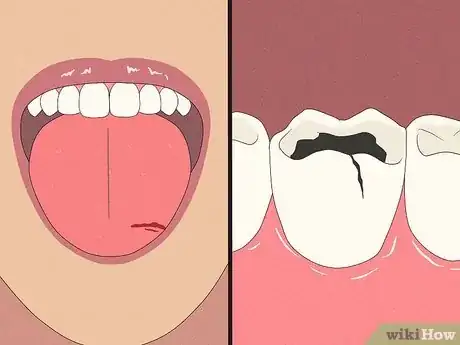





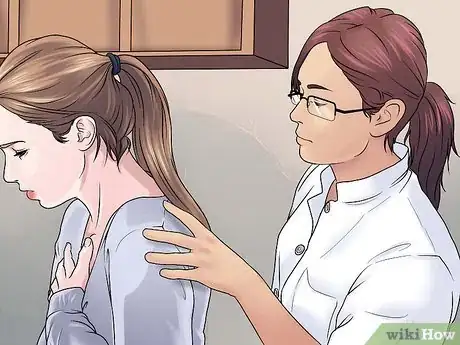


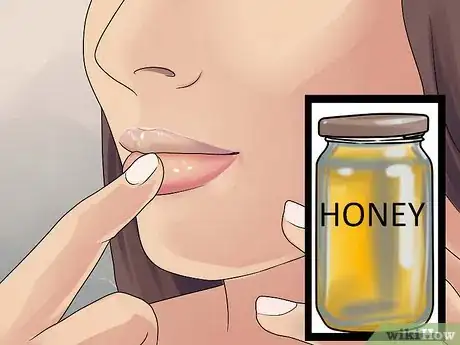




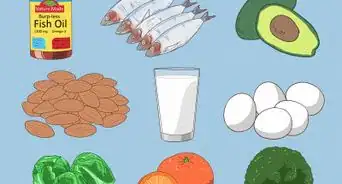

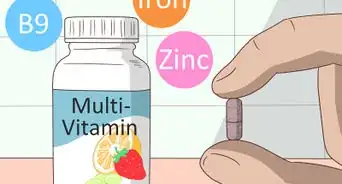







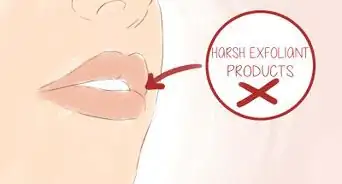












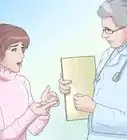





































Medical Disclaimer
The content of this article is not intended to be a substitute for professional medical advice, examination, diagnosis, or treatment. You should always contact your doctor or other qualified healthcare professional before starting, changing, or stopping any kind of health treatment.
Read More...